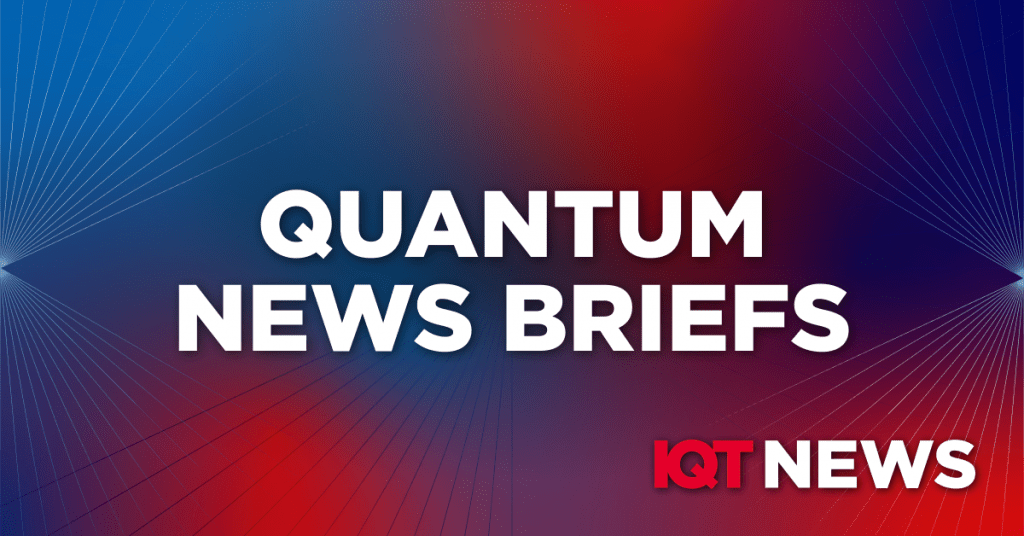News Releases:
InfinityQ announces collaborative initiative with Siemens Energy Ventures to leverage quantum-inspired computing solutions
By applying InfinityQ’s optimization tools, Siemens Energy Ventures aims to solve unique challenges in the energy business. InfinityQ has developed an environment that allows easy development and deployment of advanced algorithms tailored to specific use cases, demonstrating significant time and cost efficiency. This collaborative project showcases the potential of quantum-inspired technology in driving forward operational improvements.
SBQuantum announces new projects with European Space Agency & Canadian Space Agency
SBQuantum, the first company developing quantum diamond magnetometers capable of providing accurate readings from space, has announced a pair of new contracts with leading government agencies in space exploration.
First, the company has been contracted by the European Space Agency (ESA) to evaluate the viability of its quantum diamond magnetometer technology in space. ESA is assessing both the reliability and accuracy of SBQuantum’s sensor technology, as well as how these sensors could be deployed on a satellite in space for a range of applications. The contract focuses on applications enriching humanunderstanding of the Earth and its magnetic environment. For instance, satellite-based magnetometers can be useful in monitoring magnetic storms, which can disrupt navigation and communications here on Earth.
The Canadian Space Agency (CSA) has also selected SBQuantum, and will be testing the company’s magnetometer at an altitude of 40km as part of its STRATOS Program. The testing will demonstrate the instrument’s ability to collect precise data in temperatures as low as -60 Celsius (-76 Fahrenheit) and low-pressure environments, while also being exposed to radiation. Furthermore, this project will include a demonstration of magnetic field-based positioning (whose signal cannot be jammed) using a quantum diamond magnetometer, as opposed to relying on the heavy infrastructure of traditional GPS.
NTT DOCOMO and D-Wave improve mobile network performance by 15% with quantum optimization technology
The solution’s efficiency was demonstrated in pilot tests for certain areas in Japan (Tokai, Chugoku, Kyushu regions) when compared to classical methods. While a general-purpose solver took 27 hours, D-Wave’s hybrid solver completed the same task in just 40 seconds. The test results showed that quantum optimization led to a 15% reduction in paging signals, allowing approximately 1.2 times more terminals to be connected during periods of high call volume. This expanded bandwidth for base station resources has the potential to greatly reduce congestion, which would help the company maintain quality network traffic flow even during heavy usage.
In Other News:
SpaceNews reports: German cubesat to test quantum key distribution
Mission operators in Germany made contact with the 3.53-kilogram Qube approximately two hours after it launched Aug. 16 on a SpaceX Falcon 9 rideshare. Now, they are moving quickly through the launch and early operations phase (LEOP) of the mission.
The Qube satellite was designed and built at the University of Wurzburg Center for Telematics. The payload for quantum key distribution was supplied by the Ludwig Maximilian University, the Max Planck Institute for the Science of Light and the University of Erlangen–Nuremberg. The German Space Agency DLR research center in Oberpfaffenhofen provided the satellite’s onboard laser communications terminal.
Quantum key distribution was demonstrated in orbit by the 635-kilogram Chinese Quantum Science Satellite Micius, launched in 2016.
The Germany institutions are already planning Qube follow-ons. QUBE-2, a six-unit cubesat with “a much stronger laser payload,” is slated to launch in the second half of 2025.
InnovationAus reports “Chip breakthrough keeps Diraq on track for quantum computer”
Sydney quantum startup Diraq has claimed another technology breakthrough it says keeps it on track to deliver a useful quantum computer within four years and a fault tolerant computer ahead of bigger rivals as per August 20 article by Joseph Brookes, Senior Reporter for InnovationAus.
The company’s researchers have demonstrated consistent and repeatable operation with above 99 per cent fidelity of two-qubit gates in the SiMOS (silicon metal-oxide-semiconductor) quantum dot platform.
It’s the first time the fidelity threshold has been met for the chip technology, which the UNSW spin out is using in the race to develop the world’s first fault tolerant quantum computer. Several companies are pursuing different approaches to achieve a fault tolerant quantum computer, including Australian government-backed US firm PsiQuantum, in what has become a high stakes global race.
Diraq explained the importance of this announcement in its August 20 news release:
Team Diraq has successfully demonstrated consistent and repeatable operation with above 99% fidelity of two-qubit gates in the SiMOS (silicon metal-oxide-semiconductor) quantum dot platform.
Consistent performance is key to the underlying integrity and capability of multi-qubit systems, with reliability and consistency in high-fidelity entangling operations between qubits being the key to future sustainable quantum performance.
This also represents the first silicon-CMOS based platform to reach the significant 99% milestone for two-qubit logic.
For Diraq, achieving this benchmark represents a crucial step towards the protection against errors in solid state qubits, paving the way for realising more reliable silicon-based quantum devices.
The technical breakthrough is detailed in a study: Assessment of the errors of high-fidelity two-qubit gates in silicon quantum dots published in the journal Nature Physics.
